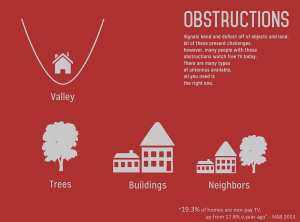TV antenna selection is more than simply imputing a zip code on a website, that’s why we have created this guide to help ease the process. Unfortunately, there is no one size fits all solution. To correctly select a TV antenna, we need some basic information about your location, then follow some important installation notes. Let’s begin.
Locate your digital television transmitters
It is important to know where your local broadcast towers are located, as there are many factors that may potentially impede your signal. TV antennas are a line of sight technology, which means getting the clearest view of your towers will bring in the strongest signal.
Learning how far away from the broadcast transmitters you are will help you decide how powerful the TV antenna will need to be. However local obstructions, installation hardware and antenna positioning are important factors in antenna selection.
This said, it is generally preferable to install your antenna as high as possible, pointed in the direction of the broadcast towers, and outdoors with as few obstructions as possible.
Using the Antenna Point tool, enter your street address and zip code to get detailed map listing distance, and direction of your local transmitters. Here you can see if the towers are located as a cluster in 1 location – like New York, Chicago, and Los Angeles – or if you will require a multi-directional antenna to receive signals from many locations.
VHF or UHF
While the majority of channels in North America are broadcast on the UHF, there may be some in your area broadcast on the VHF. This means a VHF kit may be required with your TV antenna. If the VHF channel is broadcast on a lower frequency (RF Channel 2-6) you will need a specific outdoor antenna that can receive these Lo-VHF channels. Lo-VHF is very rare but they are still out there!
Topography
The topography (or lay of the land) between your address and the transmitters may vary greatly. Obstructions such as trees, buildings or mountains may degrade or block the signal traveling to your location. Use the satellite view with the interactive map in your analysis to determine the local topography for your antenna installation. Should you encounter many obstructions, an outdoor TV antenna mounted as high as possible is usually advisable.
TIPS FOR SUCCESS
Outdoor installation is best, but Antennas Direct antennas can also be installed indoors or in attics. (50% strength/range is lost indoors).
Simple, direct connections and installations are best. The more junctions in the installation, the higher the signal loss.
Each time the signal is split (to go to another TV) signal strength is reduced, so a low-noise amplifier may be needed to help compensate for the signal reduction.
Install the antenna where signal is “present”. Move the antenna to different locations until signals are found. Many times one end of the roof or room has better signal characteristics than the others.
Ask for help
If you are not sure which TV antenna is right for you we have a dedicated team of installation experts that will gladly assist with selection, or recommend a local installer to help you get set up.
Call: 1-877-825-5572 Chat: Live Chat Mail: info@antennasdirect.com

